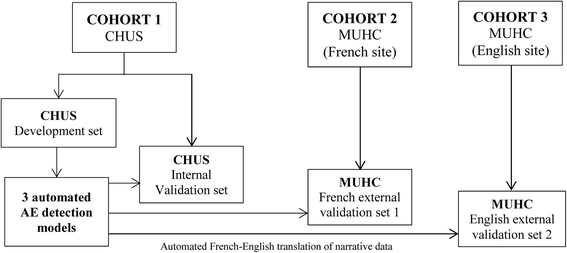Accuracy and generalizability of using automated methods for identifying adverse events from electronic health record data: a validation study protocol
- PMID: 28209197
- PMCID: PMC5314632
- DOI: 10.1186/s12913-017-2069-7
Accuracy and generalizability of using automated methods for identifying adverse events from electronic health record data: a validation study protocol
Abstract
Background: Adverse events (AEs) in acute care hospitals are frequent and associated with significant morbidity, mortality, and costs. Measuring AEs is necessary for quality improvement and benchmarking purposes, but current detection methods lack in accuracy, efficiency, and generalizability. The growing availability of electronic health records (EHR) and the development of natural language processing techniques for encoding narrative data offer an opportunity to develop potentially better methods. The purpose of this study is to determine the accuracy and generalizability of using automated methods for detecting three high-incidence and high-impact AEs from EHR data: a) hospital-acquired pneumonia, b) ventilator-associated event and, c) central line-associated bloodstream infection.
Methods: This validation study will be conducted among medical, surgical and ICU patients admitted between 2013 and 2016 to the Centre hospitalier universitaire de Sherbrooke (CHUS) and the McGill University Health Centre (MUHC), which has both French and English sites. A random 60% sample of CHUS patients will be used for model development purposes (cohort 1, development set). Using a random sample of these patients, a reference standard assessment of their medical chart will be performed. Multivariate logistic regression and the area under the curve (AUC) will be employed to iteratively develop and optimize three automated AE detection models (i.e., one per AE of interest) using EHR data from the CHUS. These models will then be validated on a random sample of the remaining 40% of CHUS patients (cohort 1, internal validation set) using chart review to assess accuracy. The most accurate models developed and validated at the CHUS will then be applied to EHR data from a random sample of patients admitted to the MUHC French site (cohort 2) and English site (cohort 3)-a critical requirement given the use of narrative data -, and accuracy will be assessed using chart review. Generalizability will be determined by comparing AUCs from cohorts 2 and 3 to those from cohort 1.
Discussion: This study will likely produce more accurate and efficient measures of AEs. These measures could be used to assess the incidence rates of AEs, evaluate the success of preventive interventions, or benchmark performance across hospitals.
Keywords: Acute care hospital; Adverse events; Automated detection; Data warehouse; Electronic health record; Natural language processing; Patient safety.
Figures
References
-
- Kohn LT, Corrigan J, Donaldson MS. To err is human. Building a safer health system. Washington: Institute of Medicine, National Acadey Press; 2000. - PubMed
-
- Canadian Patient Safety Institute (CPSI). Patient Safety Forward With Four: The National Integrated Patient Safety Strategy. 2016. http://www.patientsafetyinstitute.ca/en/About/PatientSafetyForwardWith4/...; Accessed 15 Feb 2016.
Publication types
MeSH terms
Grants and funding
LinkOut - more resources
Full Text Sources
Other Literature Sources



